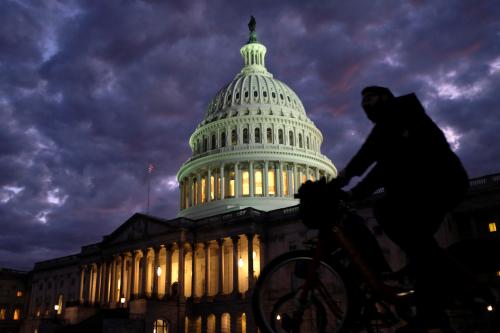Suppose most Americans were to conclude that President Trump is unfit for office. How long would it take to remove him? If President Nixon’s example provides any guidance, the answer is: a long time—if ever.

Consider the first chart, which shows Nixon’s approval ratings throughout his truncated second term, and also Trump’s approval ratings so far. (All of the approval numbers cited here are from Gallup’s Presidential Job Approval Center.) Nixon’s second-term approval started strong, in the high sixties, but plummeted as Watergate revelations emerged. By the time the Senate Watergate hearings began, in May of 1973, his ratings were under 50 percent. By the time of the Saturday Night Massacre, in October of 1973, his approval was mired in the mid-twenties, never to recover.
Still, Nixon held onto office for more than 17 months after his ratings sank below 50 percent, and for more than nine months after they sank into the twenties. Being loathed by the American public, and being widely and correctly perceived to be a criminal, did not do him in for a long time.
The reason was that the critical variable was not overall approval but Republican approval. Removal either by impeachment or under the 25th Amendment, the two mechanisms available, requires a 67-vote Senate supermajority (unless a president is too incapacitated to serve). As a result, even though Democrats controlled Congress in 1974, Nixon could not be removed without Republican legislators’ support.
The same arithmetic applies to Trump today. Even if Democrats manage to win a House majority next year, the most Senate seats they could possibly capture in 2018 (if they won every race) is 56. Unless Republican Senators, and quite a few of them, defect from Trump, he stays put until at least January 2021.
In 1974, as today, Republican legislators were fearful of the political consequences of abandoning a Republican president who enjoyed Republican partisans’ support. That was one reason they protected him for so long. So a key question becomes: when did the Republican base sour on Nixon, making it safe for party leaders to eject him?

The answer, as shown in the second chart, is: never. To the bitter end, his Republican approval stayed at or above 50 percent (with only minor and temporary exceptions). In other words, Nixon divided Republicans but never lost them, despite his evident and gross malfeasance.
Because the Republican Party of 1974 was more moderate and heterogeneous than the Republican Party of today, we can expect today’s Republican base to be even more likely to protect Trump than yesterday’s Republican base was to protect Nixon. With that important fact in mind, consider Trump’s numbers.
Among the general public, Trump’s ratings are already low, at levels Nixon hit when he was well into his Watergate free-fall. As of mid-June, however, Trump’s approval ratings among Republicans had never dropped below 80 percent. Among Republicans, in other words, Trump is where Nixon was before Watergate.
Although Nixon retained the support of half his party to the end, Republicans in the Senate finally stopped protecting him when the Supreme Court ordered him to turn over tapes documenting his dishonesty. In August of 1974, GOP Sen. Barry Goldwater fulminated, “There are only so many lies you can take, and now there has been one too many.”
Might some decisive event—Trump’s own version of the smoking-gun tape—kick the Republican props out from under Trump? Maybe. But Trump’s strategy is antithetical to Nixon’s. Nixon maintained a façade of probity and normalcy. Trump doesn’t bother. He has publicly asked the Russians to tamper with U.S. elections, publicly helped cover for their having done so, and then publicly acknowledged firing the FBI director for investigating the matter. His weaponization of flagrance, as I have argued elsewhere, draws his supporters into complicity. Given that his Republican approval has stayed in the eighties, the GOP base appears to have priced in, so to speak, his deviant and erratic behavior.
Perhaps there are limits to Republicans’ tolerance, but if Trump hasn’t already triggered them, it is hard to imagine where they are. The firing of a special prosecutor? An indictment? Possibly, but one wonders if it might be literally true that Trump could, as he once boasted, shoot someone on Fifth Avenue and retain Republican support.
The numbers support no predictions, but they offer a hint. Even under a worst-case scenario of presidential malfeasance, removing Trump would be no easy or quick task. It would require a sea-change in Republican partisans’ attitude, a change of which there is no sign today. And it would require Republican leaders to take political risks that few have shown any appetite for.
Grace Gilberg contributed to this post.







Commentary
Impeaching Trump is a heavy lift
June 16, 2017